
Nuremberg is the second-largest city of the German state of Bavaria after its capital Munich, and its 541,000 inhabitants make it the 14th-largest city in Germany. On the Pegnitz River and the Rhine–Main–Danube Canal, it lies in the Bavarian administrative region of Middle Franconia, and is the largest city and the unofficial capital of Franconia. Nuremberg forms with the neighbouring cities of Fürth, Erlangen and Schwabach a continuous conurbation with a total population of 800,376 (2019), which is the heart of the urban area region with around 1.4 million inhabitants, while the larger Nuremberg Metropolitan Region has approximately 3.6 million inhabitants. The city lies about 170 kilometres (110 mi) north of Munich. It is the largest city in the East Franconian dialect area.

Adolf Fredrik Church is a church in central Stockholm, Sweden, named after Adolf Frederick. It was built in 1768–1774, replacing a wooden chapel from 1674, which was dedicated to Saint Olof. It was inaugurated on 27 November 1774.
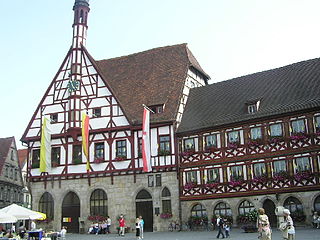
Forchheim is a town in Upper Franconia in northern Bavaria, and also the seat of the administrative district of Forchheim. Forchheim is a former royal city, and is sometimes called the Gateway to the Franconian Switzerland, referring to the region of outstanding natural beauty to the north east of the town. Nowadays Forchheim is most famous for its ten day long beer and music festival (Annafest) which takes place in late July in an idyllic wooded hillside, home to 24 beer gardens, on the outskirts of the town. Forchheim's population, as of December 2013, was 30,705, and its land area is 44.95 square kilometres. Its position is 49° 44' N, 11° 04' E and its elevation is 265 metres above sea level.

The Nuremberg U-Bahn is a rapid transit system run by Verkehrs-Aktiengesellschaft Nürnberg, which itself is a member of the Verkehrsverbund Großraum Nürnberg. The Nuremberg U-Bahn is Germany's newest metro system, having begun operation in 1972, although the Nuremberg-Fürth route (U1) uses part of the right of way of the Bavarian Ludwig Railway, Germany's first passenger railway opened in 1835. The current network of the U-Bahn is composed of three lines, serving 49 stations, and comprising 38.2 kilometres (23.7 mi) of operational route, making it the shortest of the four metro systems in Germany, behind Berlin, Hamburg and Munich.
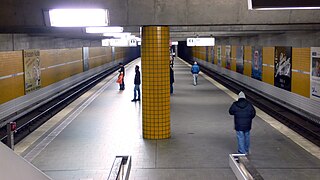
Gostenhof station is a Nuremberg U-Bahn train station, in Nuremberg, Germany. It is located on the U1 line.
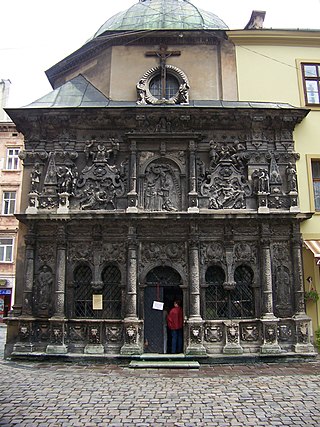
The Boim Chapel is a monument of religious architecture in Cathedral Square, Lviv, Ukraine. It was constructed from 1609 to 1615 and is part of Lviv's Old Town, a UNESCO World Heritage Site.

Buttenheim is a market town in the Upper Franconian district of Bamberg and lies in the Regnitz Valley between Bamberg and Nuremberg, Germany.

Holsthum is a municipality in the district of Bitburg-Prüm, in Rhineland-Palatinate, western Germany.

Nittel, on the Upper Moselle, is an Ortsgemeinde in the Landkreis [county] of Trier-Saarburg in the state of Rhineland-Palatinate. It belongs to the Verbandsgemeinde [United Municipalities] of Konz. The place, located between dolomite and limestone cliffs, is a nationally recognized resort.

Khovanskoye Cemetery, also known as Nikolo-Khovanskoye Cemetery, is a large and expanding cemetery servicing Moscow, Russia. It is located in the Leninsky District, Moscow Oblast, beyond the Moscow Ring Road, at the 21st kilometre mark of the Kiev Highway by the Mosrentgen and Nikolo-Khovanskoye settlements.

Johann Christoph Volkamer was a German merchant, manufacturer and botanist.

The Nuremberg Transport Museum is based in Nuremberg, Germany, and consists of the Deutsche Bahn's own DB Museum and the Museum of Communications. It also has two satellite museums at Koblenz-Lützel and Halle. The Nuremberg Transport Museum is one of the oldest technical history museums in Europe.

The Chapel of St. Roch is a German pilgrimage chapel, dedicated to Saint Roch, located on the Rochusberg southeast of Bingen am Rhein.

The Imperial City of Nuremberg was a free imperial city – independent city-state – within the Holy Roman Empire. After Nuremberg gained piecemeal independence from the Burgraviate of Nuremberg in the High Middle Ages and considerable territory from Bavaria in the Landshut War of Succession, it grew to become one of the largest and most important Imperial cities, the 'unofficial capital' of the Empire, particularly because numerous Imperial Diets and courts met at Nuremberg Castle between 1211 and 1543. Because of the many Diets of Nuremberg, Nuremberg became an important routine place of the administration of the Empire during this time. The Golden Bull of 1356, issued by Emperor Charles IV, named Nuremberg as the city where newly elected kings of Germany must hold their first Imperial Diet, making Nuremberg one of the three highest cities of the Empire.

The Imhoff, Imhof or Im Hof family is a noble patrician family that belonged to the wealthy trading dynasties and ruling oligarchy in the Free Imperial City of Nuremberg during its Golden Age in the Renaissance. The Imhoff Trading Company was one of the most important European traders between the 15th and 17th centuries. It maintained branches and trade connections throughout Europe and financed European courts with loans.
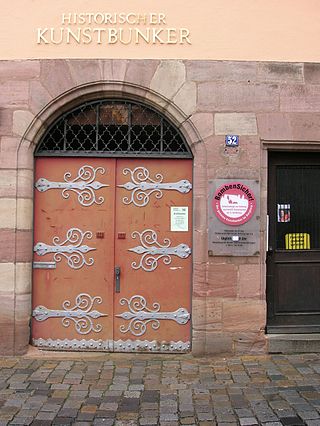
The Historische Kunstbunker is a tunnel complex under Nuremberg Castle in the old city of Nuremberg, southern Germany. It forms part of the Nuremberg Historic Mile.
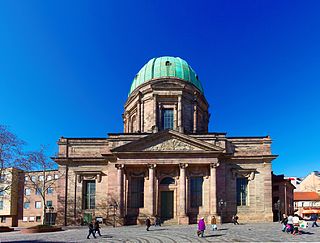
St. Elizabeth's is a Roman Catholic church in Nuremberg in southern Germany. It is dedicated to Elizabeth of Hungary.

The Toplerhaus was an important Renaissance town house in the German city of Nuremberg. It was named after the patrician family Topler and was among the most elaborate of the late Renaissance residencies in the city. It was destroyed in a bombing raid in World War II.

Nuremberg City Hall is located in the old town of Nuremberg, Germany, just east of the choir of the Sebalduskirche. It is part of the Historic Mile of Nuremberg as one of the city's sights. The imposing Renaissance building was designed by architect Jakob Wolff the Younger (1571–1620). It was severely damaged during World War II and was largely rebuilt in the 1950s. In the process, the structure was shortened by two window axes on the north side. On the south side is a core Gothic hall designed by Albrecht Dürer. The Lochgefängnisse, located in the basement, are considered a tourist attraction, as is the Beautiful Fountain, located directly in front of the New City Hall, designed by Kurt Schneckendorf and built from 1954 to 1956. This building replaced the row of houses between the Old Town Hall and the Hauptmarkt, which had been destroyed during the war.


























